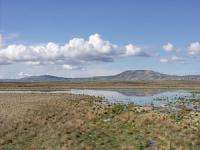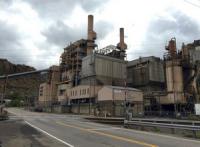-
Sea levels could rise by more than three meters: New study
Global sea levels could rise by more than three meters – over half a meter more than previously thought – this century alone, according to a new study. The projections explicitly accounted for three scientific uncertainties – the speed at which the Antarctic ice sheet is going to melt, the speed at which the ocean is warming up, and the amount of emitted greenhouse gases over the twenty-first century.
-
-
Western U.S.: Loss in water from melting snowpack due to human influence

Peak runoff in streams and rivers of the western United States is strongly influenced by melting of accumulated mountain snowpack. A significant decline in this resource has a direct connection to streamflow, with substantial economic and societal impacts. An international team of scientists has found that up to 20 percent loss in the annual maximum amount of water contained in the western United States’ mountain snowpack in the last three decades is due to human influence.
-
-
Yes, we can do “sound” climate science even though it’s projecting the future
Increasingly in the current U.S. administration and Congress, questions have been raised about the use of proper scientific methods and accusations have been made about using flawed approaches. This is especially the case with regard to climate science, as evidenced by the hearing of the House Committee on Science, Space and Technology, chaired by Lamar Smith, on 29 March 2017. Chairman Smith accused climate scientists of straying “outside the principles of the scientific method.” Smith repeated his oft-stated assertion that scientific method hinges on “reproducibility,” which he defined as “a repeated validation of the results.” He also asserted that the demands of scientific verification altogether preclude long-range prediction. The kinds of statements are misguided. They show a woeful ignorance about science and how it works, and in particular about climate science. Consequently, they ignore sound advice on how to best plan for the future.
-
-
Planet’s response to greenhouse gas emissions: Models, observations not so far apart
How hot our planet will become for a given amount of greenhouse gases is a key number in climate change. As the calculation of how much warming is locked in by a given amount of emissions, it is crucial for global policies to curb global warming. It is also one of the most hotly debated numbers in climate science. Observations in the past decade seem to suggest a value that is lower than predicted by models. But a University of Washington study shows that two leading methods for calculating how hot the planet will get are not as far apart as they have appeared.
-
-
BP oil spill did $17.2 billion in damage to natural resources

The 2010 BP Deepwater Horizon oil spill did $17.2 billion in damage to the natural resources in the Gulf of Mexico, a team of scientists recently found after a six-year study of the impact of the largest oil spill in U.S. history. This is the first comprehensive appraisal of the financial value of the natural resources damaged by the 134-million-gallon spill.
-
-
Clean power planning

With a single executive order issued at the end of March, the Trump administration launched a robust effort to roll back Obama-era climate policies designed to reduce U.S. carbon dioxide (CO2) emissions. Chief among those policies is the Clean Power Plan, which targets coal and natural gas-fired electric power plants that account for about 40 percent of the nation’s CO2 emissions. Private and public-sector investors may see the executive order as a green light to double down on relatively cheap fossil fuels and reduce holdings in more costly, climate-friendly, non-carbon generation technologies such as wind, solar and nuclear. But they may want to think twice before making such transactions – and a new study details why it’s prudent to invest in carbon-free electricity now.
-
-
Sustainability’s threat to fossil fuel industry is only going to increase
Commercial activity in fossil fuels is increasingly at odds with global actions to reduce the threat of climate change. Burning coal, oil, and natural gas is responsible for two-thirds of humanity’s emissions of greenhouse gases, and yet provides more than 20 percent of GDP in two dozen nation states. By Citicorp’s estimate, current commitments to reduce these emissions could mean forgoing $100 trillion in fossil fuel revenues by 2050 — representing a huge disruption to global affairs, undermining national budgets and corporate balance sheets while exposing stakeholders, including pension holders and ordinary citizens in resource-exporting states, to myriad risks.
-
-
Latest science on sea level rise projections: In support of California policy guidance
An estimated 75 percent of California’s population lives in coastal counties. Sea-level rise, already underway, threatens hundreds of miles of roads and railways, harbors, airports, power plants, wastewater treatment plants, coastal wetlands, beaches, dunes, bluffs, and thousands of businesses and homes. In a comprehensive analysis of the factors that affect how much the ocean will rise along California’s coast in coming decades, a seven-member team of experts has provided the state with a report on the best-available sea-level rise science — including recent scientific advances on the role of polar ice loss.
-
-
Cities inland could be reshaped by migration from sea-level rise
When Hurricane Katrina struck Louisiana in 2005, cities inland saw an influx of evacuees escaping the storm and its aftermath. Now, a new study predicts that this could happen again as a result of sea-level rise. Researchers estimate that approximately 13.1 million people could be displaced by rising ocean waters, with Atlanta, Houston, and Phoenix as top destinations for those forced to relocate. The study is the first attempt to model the destination of millions of potentially displaced migrants from heavily populated coastal communities.
-
-
Climate change: Less impact on drought than previously expected
As a multiyear drought grinds on in the Southwestern United States, many wonder about the impact of global climate change on more frequent and longer dry spells. As humans emit more carbon dioxide into the atmosphere, how will water supply for people, farms, and forests be affected? Reduced precipitation will increase droughts across southern North America, southern Europe and northeastern South America. But the results show that in Central Africa and temperate Asia—including China, the Middle East, East Asia and most of Russia—water conservation by plants will largely counteract the parching due to climate change.
-
-
Space technology identifies land degradation in West Africa
Researchers map regional droughts from space which can affect the livelihood of millions of people in West Africa. Soil moisture observations can map land degradation with more accuracy than typical rainfall data as soil moisture directly leads to plant growth. Study shows that the land conditions across much of West Africa have improved between 1982 and2012 based on soil moisture observations.
-
-
New resilience study helps governments prevent disaster-related loss
Hurricanes, wildfires, tsunamis, and other disasters cannot be stopped, but countries can plan for them — something some areas of the world seem to do better than others, according to a new study. In the study, thirty-eight factors that affect a country’s resilience were derived from national and international databases, and the researchers used these databases to grade the resilience of each country and continent and develop a comprehensive index that includes indicators such as the number of disasters and their death tolls, as well as an area’s population, infrastructure, economy and educational system.
-
-
Future CO2 levels, climate warming unprecedented in 420 million years
New research suggests that, over the next 100 to 200 years, carbon dioxide concentrations in the Earth’s atmosphere will head towards values not seen since the Triassic period, 200 million years ago. Furthermore, by the twenty-third century, the climate could reach a warmth not seen in 420 million years.
-
-
Bringing values, not just facts, to climate fight
The facts, unfortunately, don’t speak for themselves. That’s why scientists have to speak out, according to Naomi Oreskes, a Harvard history of science professor who has taken a close look at the causes and effects of climate change denial. Denial, she said, isn’t about science but about individualism, skepticism of government power, the self-interest of those in affected industries, and conceptions of freedom. For those moved by those concerns, climate change is just the latest in a series of scientific problems leading to greater government intrusion. Disputing climate facts has roots in fear, Oreskes said — not of climate, but of higher taxes, bigger government, and lost freedoms.
-
-
Managed retreat: Relocating communities to get them out of harm’s way
More frequent extreme weather events put certain regions in the cross hairs of risks such as coastal flooding, heavy rain, and erosion. There is an obvious, but controversial, solution: relocating communities from vulnerable to safer areas. Based on examples from around the world, researchers chart the landscape for whether and how to implement the strategy of managed retreat – and how, with the minimum disruption possible, relocate or abandon development in the face of extreme weather risks.
-
More headlines
The long view
How Climate Change Will Affect Conflict and U.S. Military Operations
“People talk about climate change as a threat multiplier,” said Karen Sudkamp, an associate director of the Infrastructure, Immigration, and Security Operations Program within the RAND Homeland Security Research Division. “But at what point do we need to start talking about the threat multiplier actually becoming a significant threat all its own?”
